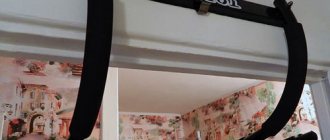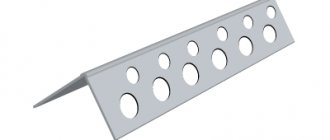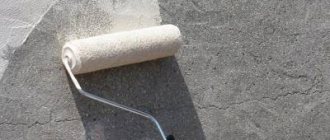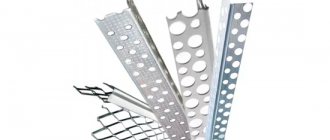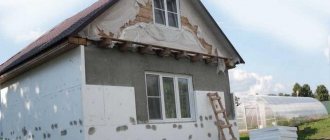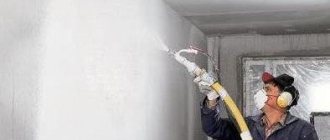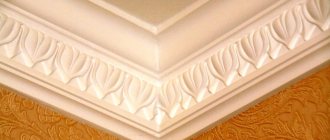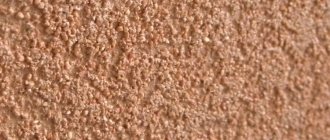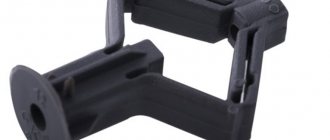Painting corners help create an even connection between the surfaces of walls, door and window slopes. They help make a right angle between the walls, and also strengthen the finish at the joint, protecting against chips and cracks. In this article we will look at the types of plaster corners and methods of attaching them.
The photo shows a plastic perforated profile for plaster
Plaster corner and its varieties
Metal corner
Each owner, when undertaking renovations in his premises, very often faces the problem of leveling the walls and creating a high-quality cover for organizing the finishing. Paying attention to the corners in the room where the renovation will be done, many people do not know how to properly align them.
Modern developers involved in the production of various construction products have created and introduced into the “construction world” such an invention as a plaster corner, which is grateful not only to professional finishers, but also to ordinary people who independently carry out repairs in their apartments.
Plastic corner
This item is used to form an even internal or external corner. Despite its simple design, it requires certain skills to install it.
Today there are 2 types of design:
- metal profiled corner;
- plastic corner.
Metal corners for plaster
Aluminum fittings are lightweight and more reliable than the galvanized version
Plaster corners made of metal are classified according to the shape of the structure and material.
The materials used for the production of this type of plaster corners are galvanized steel and aluminum.
Despite the fact that aluminum can be classified as a rather soft metal that requires careful handling, corners made from it are widely used, since the material is slightly susceptible to corrosion, and products made from it can last for many years. In addition, the aluminum corner is lightweight, which subsequently does not place additional load on the surface.
A corner made of galvanized steel is more susceptible to atmospheric influences than its aluminum counterpart, but at the same time has greater reliability.
According to the shape of the structure, all metal corners for plastering work are divided into 3 types:
- Regular angle. It looks like a metal strip, bent at 90, up to 0.5 mm thick. Usually, depending on the manufacturer, there are perforations on the sides of the product, which lighten the weight of the product and give it additional adhesive properties.
- Plaster corner with mesh. Metal corners of this sample are widely used in wet plastering. The design feature of this product is that a metal mesh 2-4 cm wide is attached to the corner using special pads. Using this design, you can level a wide variety of surfaces.
- Combined angle. This is a type of metal structure consisting of aluminum or galvanized corner and fiberglass mesh. With its help, clear angle shapes are created on the surface, and the joint is formed correctly using a mesh. To find out which option is better to choose, watch this video:
Plastic plaster corners
Plastic structures for plastering corners create quite a lot of competition with metal analogues in the building materials market. There are several types of plastic linings installed in the corners:
- Standard plastic corner. Similar to metal structures. Its main difference is that it does not corrode. Its main drawback is the thickness of the product, which can exceed 1-1.5 mm, and makes its use impossible when putting surfaces, but it is excellent for plastering work.
- Arched plastic corners. The structures help to create a high-quality arched opening in the room. Due to the segmentally divided 1 edge of the corner, its surface can be bent to different radii, thereby creating an even angle even in a difficult situation.
- Corners with overlay mesh. Such products are used in places where a thick layer of plaster will be applied. Mesh extensions create an additional fixing base. This results in a high-quality angle even in the most difficult conditions.
- Universal angle. It has a mesh design and can be used to create non-standard angles (different from the usual 90 angles) due to the high-quality plastic used and a specially created fold line.
What is it intended for?
Finishers use perforated corners to apply plaster and “remove” corners in the room. Such elements are ideal for novice repairmen who do not have proper experience in plastering work.
The product is used in various fields:
- with its help wall surfaces and partitions are lined;
- internal and external corner areas are strengthened;
- the finishing layer on boxes and arches is strengthened and its shedding is prevented;
- transitional areas near walls and ceilings are beautifully designed;
- When plastering, the corners act as beacons.
The angle for plastering corners is used on any building materials, but it “works” especially well with gypsum plasterboard, the sheet edges of which begin to crumble without proper protection. The cross-section of a right angle resembles the letter “V” from the English alphabet, on the flat sides of which there is a huge number of holes.
The construction accessory is attached to the corners of the walls with putty or plaster mixture, leveling the surface. The corners differ in thickness parameters and manufacturing materials, have different widths and strength ratings.
There are two types of corners:
- external, the top of which is directed outward;
- internal - in such a product the corner is directed inward.
The top is used to determine how to strengthen the product; with the help of perforations located at the edges, the part is tightly fixed to the surface.
It is not recommended to cover the outer corner with a thick layer of plaster at the time of installation - it will crumble over time.
But to seal the inner corner of the mortar, they do not spare any effort in order to further strengthen the joints.
Finishing external corners
Processing external corners during new construction or renovation of premises can also be done in 2 ways. The first of them involves the introduction of a corner profile made of metal. This method makes it possible to plaster both combined walls at once and ultimately obtain a strong corner.
The second method is to first plaster one side of the corner using a beacon strip, and then the other.
The iron corner profile allows you to form an even and reliable outer edge of the walls without any special problems. Mesh shelves are adjacent to the central part of the profile on both sides. Their thickness can be different, depending on the model of the slats. Before you apply a continuous layer of primer, the solution that secures the profile must be allowed to dry properly.
The corner lath can also be placed on a narrow layer of plaster consistency, spread in a continuous strip from the ceiling to the floors. Then setting the profile by level is even easier. All metal corner profiles can be shortened if necessary.
The side shelves are cut with metal scissors, and the central part with a metal saw. A fixed strip can also be used as a beacon when smoothing a layer of plaster primer.
Once the mixture has set, it needs to be cut using a metal trowel, thus freeing up space for covering. It is spread as usual; the thickness is determined by the angular profile. To round the resulting plastered corner, lightly sand it with small sandpaper.
How to install correctly?
We suggest you understand the rules for installing corners, because the operational period of the entire coating depends on this. The following conditions are met:
- the corner is installed on a solid section of the wall;
- the installation site is covered with a primer mixture, like the main surface;
- The corner is fixed using beacons;
- the entire perforation is filled with the mortar mixture;
- when installing the product vertically, use a building level;
- if plastering is to be done with a thin layer, the corner is installed on screws or dowels;
- corner areas are plastered at the final stage;
- in their work they use special tools that are used to finish corner areas;
- Such places are rubbed one at a time; it is recommended to ensure that the corner slats do not protrude outward.
If the corner is not completely covered with the mortar mixture, it is sealed with any leveling compounds or sealant.
The main feature is that the corner pad must be installed correctly. There are some nuances here, knowledge of which will help you cope with such work without any problems.
Internal corner areas are finished alternately or simultaneously, the procedure in any of the cases remains the same:
- spray and a layer of soil are applied, the area is leveled using the rule, movements are directed from the corner in both directions. Markings are made on the mixture, after which the formation of the corner begins;
- the edge of the trowel is applied to the wall surface at thirty to forty degrees, the tool is brought to the inner corner, laid on the wall and grouted. After this, the trowel is pressed with its edge onto the fresh solution with its base;
- when pressing the tool, a force is created, due to which the device is cleaned;
- As soon as the primer has dried, apply a coating and level the layer with a grater. At the final stage, the tool is positioned so that one edge of it is on the plaster layer, and the second is lightly passed over the freshly applied mortar;
- with a grater they work vertically around the entire corner, creating a strictly even edge.
External corners are finished as follows. Some use metal profiles, with the help of which the action is performed simultaneously on both sides. The second option is to process the plots one by one.
The corner is installed on the applied solution, after which the primer is applied after drying. The corner slats are attached in a thin layer, and all edges from the floor covering to the ceiling are lubricated with the solution. The excess part of the corner is cut off with metal scissors.
The areas around window and door openings are also plastered using corners. To ensure that the layer is applied evenly, the work is carried out in several stages:
- areas for installing profiles are cleaned and primed;
- a plaster solution is applied to the prepared surface using a spatula;
- profile guides are installed and the mixture is coated on top;
- dried slopes are cleaned with sandpaper.
Adviсe
Alignment of the internal corner is carried out by making a beacon directly in the corner, with further tightening of the corner by the width of the rule. It should be borne in mind that the longer the rule used, the smoother and less noticeable the transition from the inner corner to the wall will be.
Before aligning the corners, you should use a rule to evaluate their overall curvature. By applying the rule to the corners, humps and recesses are identified and they are outlined with a pencil, so that in the future you can navigate in which places and how much to apply the solution.
Next, treat the surface of the corners with a deep penetration primer. This will strengthen the surface of the walls and ensure good adhesion of the putty. Priming should be done to a width greater than the length of the rule used. After the soil has completely dried, you can begin making a lighthouse in the corner.
The lighthouse is a path of prepared gypsum plaster 5 cm wide. To make it, the gypsum mixture is diluted and mixed twice (to ensure the complete disappearance of lumps). Next, the mixture is applied in a corner to the wall and leveled vertically, forming a flat surface (including vertically).
Achieving a flat surface can be achieved using a level and additional support points for the beacon (existing protrusions and self-tapping screws screwed into the wall can be used as support points). Two walls meet in the corner, so you will need to make a second beacon on the other wall (after the first beacon has dried).
After the beacons have dried, you can tighten the walls using the rule
As a result, it is important to reduce the corner and the wall to nothing. After applying putty to the wall (to the length of the rule), you should rest it with one end on the beacon, the other on the wall and then pull off the excess
To prevent thin layers of putty from tearing, you need to use a spray bottle before re-taping.
To fill in scratches and grooves, you can apply another thin layer (apply as a rule after the plaster has completely hardened). Then you need to wait for the applied layers of plaster to dry and sand the surface.
The video will demonstrate the process of plastering internal corners.
How to use
Working with corner overlays consists of several stages, these are:
Preparing the wall
In order for the plaster to hold tightly, you should break off everything that is loose, so that a monolithic structure remains without any cracks or breaks. Do not skimp on the solution, because in the end the corner will only be stronger. Once you have knocked off all the loose pieces, you should move on to cleaning and priming. Remove dust from the surface with a special brush (but you can also use a simple rag), then prime the wall to ensure reliable adhesion to the solution.
Sometimes the wall joint is so damaged that a corner cannot even be attached to it, because there is simply nowhere to do it. In such cases, the surface is first plastered, preparing the base, and only then the corner overlay is installed on it.
And the last stage of preparation is the installation of beacons, which contribute to a more accurate location of the corner, with minimal deviations.
Product Installation
First you need to trim the overlay. Cut it with tin snips if it is steel or aluminum, or with a knife if it is plastic. Next, apply the solution to the wall and place the product on the corner. Press down lightly so that the solution begins to seep through the holes, and press down the mesh, if there is one, as firmly as possible. Check the correct installation using a level, and do not forget to check the beacons.
If the pad is made of heavy materials such as steel, then due to its large mass it will move down a little, so it would be a good idea to hold it for a while, especially if you are attaching it to the ceiling.
Using Fasteners
Holes in the corners are made not only to increase adhesion, lighten the structure and ensure the passage of the solution, but also in some cases to use screw fastenings. Plastic sleeves are driven into the hardened plaster, into which stainless screws are then screwed. This fastening allows you to significantly increase traction, but is used when it is not possible to use a mesh. And there is practically no point in using them at the same time, unless you are installing a corner in an elephant nursery.
When the solution under the pad dries
After the overlay firmly adheres to the wall, you should begin plastering the outer part of the corner and leveling it. The first step is to plaster everything next to the overlay to get the approximate thickness of the layer applied to the corner. When you have leveled the surface of the wall and the surface of the corner, start smoothing the plaster, but you should not get too fanatical - anyway, later, when it dries, it will need to be treated with sandpaper.
How to check your work
After completing each step, you should ensure that it was completed correctly. So, if in the middle of work you notice that you haven’t cleaned the wall well and there are broken pieces of plaster hanging on it, don’t be lazy, remove the corner and do it all over again, this will significantly increase the service life of the structure. If, for example, you notice that you pressed a corner onto the mortar too hard, so that it all flowed out through the perforation, remove it and put on new plaster, because the final result of your work depends most on such little things.
How and what to glue
All that remains is to glue the plastic corner onto the corner edge of the slope. First of all, you will need to choose how to glue the plastic corner to the wall. Salons and hardware stores will recommend the Liquid Nails adhesive composition as the most suitable product. The only positive characteristic is the convenient packaging in the form of a tube.
Everything else is up to the manufacturer. This composition can be used to glue lightweight polyurethane bovelacci or a plastic corner measuring 10x10 mm to the joint between the tiles. In addition, the white adhesive mass becomes beige-gray over time, so traces of glue are very clearly visible on the seams and joints.
Slopes on windows and entrance doors must be glued with silicone; it can be transparent, but if desired, you can easily choose a colored version of the sealant. Not all adhesive materials adhere well to the smooth surface of PVC corner. Silicone sealant is a pleasant exception; it does not flow or shrink.
But the main advantage is to obtain a durable and elastic seam. If you have to glue something to a door frame or to light partitions that vibrate with every door slam, choose silicone. Any other adhesives that produce the strongest and stiffest seams cannot withstand vibrations and chip, especially when it comes to a plastic corner.
The technology for gluing a corner plastic strip is quite simple. Apply glue in thin lines to the inner surface of each shelf. If the glue is very thick, then the adhesive mass can be applied to the wall with short oblique lines or dots. You cannot cover the entire surface of the wall with a continuous layer. Firstly, such a plastic profile will be impossible to press into place, and secondly, 50% of the adhesive mass will be squeezed out uselessly beyond the corner. If the glue is too liquid, it will simply leak out from under the plastic strip.
Carefully place the prepared plastic corner with glue applied onto the gluing area. To ensure a strong adhesive seam, you need to carefully press the bar into place.
A small amount of adhesive mass may be squeezed out from under the plastic profile, but do not rush to remove it - first you need to level the corner. The polyvinyl chloride profile is very flexible, and it will not be possible to straighten it by hand, so the laid corner is brought into a straight state using a metal ruler and a building level. To prevent the plastic corner from falling off the wall and sliding down until the glue dries completely, you need to secure it with several strips of tape.
We glue the next strip of plastic profile in the same way, but before laying it in place you will need to apply a small amount of glue to the joint line. After settling, part of the glue will protrude at the joint; all excess can be removed only after the adhesive mass has completely dried. Until the glue has dried, any attempts to remove excess glue will lead to stains on the wallpaper.
Sometimes there is a problem with the length of the arched corner. The maximum length of the plastic strip is 3 m. This may not be enough if the arched opening is made across the entire width of the room; the length of the corner profile on such an arch can reach 3.5-4 m. In this case, the arched arc has to be sharpened with a small piece. It is best to make the central part of the arc solid, add two small sections to the sides, and seal the joint line with silicone sealant in the color of the plastic material.
After a couple of years, due to shrinkage processes, the seams may come apart a little, but the arch will still retain its original effectiveness. If you increase the length of the plastic corner on one side, the joint will be perceived as a stain and spoil the impression of the entire structure.
Is it possible to make a corner without a corner?
By and large, yes. But you need to understand that the corner overlay is used not only to form a joint between wall surfaces, but also to strengthen it and make it resistant to mechanical damage. Without an overlay, your corner will crack from the slightest shock, and if we are talking about an apartment, you will have to plaster it again in about half a year. Finishing without overlays is used when there is absolutely no threat of impact loads, which is extremely rare.
What is a straight perforated corner
A straight perforated corner is a metal or plastic corner trim that is secured with plaster or putty, thereby giving the wall a smooth appearance and making its corners stronger.
It can be external and internal, as well as different in width and strength. For example, a wide galvanized corner is much stronger; it is also used as a beacon for plaster.
- It is better to take scissors for trimming corners with a plier-shaped type, they are very strong and sharp. With ordinary scissors, you will simply damage the edges of the corner, and the work will be lengthy and inconvenient.
- If it is a plastic corner, then large sewing scissors will do; sometimes you can cut it with a construction knife, but then the edges will have to be leveled using pliers or a hammer.
- The right corner looks like two long rulers folded in half, and on each edge there are round holes - this is a perforation with its own top.
The top of the inner corners is directed inward, and the outer corners are directed outward.
The perforation is for fastening, and the apex is for direction; the craftsmen orient themselves towards the apex and guide the spatula along it.
If you have a lot of work to do, where you need to cut a lot of corners, then do the following best: put them in a row, measure them, lift them to a height and cut them with a grinder. This will make working quickly and conveniently, and you won’t have to align the corners. Metal corners can be cut with pliers three at a time, this is faster.
Grouting corners and leveling wall surfaces
After the plaster mixture has hardened in the places where the corner pads are placed, plastering work is carried out in stages:
- using a trowel placed at an angle of 30-40°, the base is grouted;
- then a solution is applied near the profiles, which is smoothed using a rule to eliminate excess mixture;
- smooth the surface with a trowel;
- the bases are leveled, while the corners should not protrude outward;
- Polymerization is carried out on the dried wall panel and the final grouting begins;
- internal corners are rubbed using a grater with a sponge surface.
Plastering external corners
People who do not understand how to plaster the corners of walls may not understand what we are about to talk about. The fact is that there are two types of angles - internal and external. First, it is worth discussing the process of plastering the external corners, because this process is considered simpler, and any beginner can handle it on their own.
Experts advise leveling the plaster on external corners using special corners - the latest tools to facilitate the process of repair work, acting as beacons. Glued reinforcement mesh can also be used for this, which is also an incredibly attractive option for use.
The fact is that plastering using corners can boast a large number of advantages, despite which, unfortunately, it is often not recognized by builders with extensive experience. Here is a list of these advantages:
- the plaster will definitely not crumble, thanks to the steel beacon that strengthens the coating;
- you can make the coating monolithic with the help of additional reinforcing mesh, because it will very reliably connect the two walls;
- you will no longer need to carefully smooth out the external corners, because the lighthouse will be pre-set to the required level, which will become the zero point in the process of plastering the wall;
- the time that will be spent on plastering external corners along the beacons will not even compare with what you would spend on simple plastering without modern means.
Let's start work
To begin work, you need to find the place on the wall that protrudes the most. We are, of course, talking about those irregularities that cannot be leveled or eliminated in any other way. This point will become the starting point for the entire process of installing beacons.
Please note that absolutely all beacons must be installed strictly at the same level. Otherwise, there is a high risk of getting an uneven wall as a result
You can check the installation using the rule of a sufficiently long length. Just apply this tool to the outermost beacons, and then check that all the others fit tightly enough to it.
The corner can be plastered only after such work has been completed (all beacons must be well fixed). Any experts will tell you: “First we plaster the corners, and then we just go over them with sandpaper.”
It is important to choose the right angles used for this process. Different types suit different situations
If after the plastering process you are going to start gluing wallpaper, then you should use sharp corners.
As for decorative plaster, a rounded version will look better
As you may have already understood, plastering external corners is simple; all that remains is to consider the process of working with internal ones, when plastering which it is important to follow the technology, as well as competently work with beacons, which are somewhat more difficult to install in such situations
How to use the corner and what it is intended for
The corner is used by installation method in two cases:
- If there is a crooked angle. Then the corner needs to be cut along the edges and adjusted so that the corner takes on an even appearance, then putty and dry, again, and if necessary, three times.
- Conventional fastening, on a straight (even) angle, uses a perforated corner.
External corner
Please note that you should not cover an even corner with plaster too much on the outer corner. Otherwise, it will then crumble under the finishing material, for example, wallpaper.
It is better to go through it once, so that the plaster is inside the perforation and slightly covers the corner. The corner of the corner itself should not be completely covered.
Strong fixation is necessary only where the outer corner itself is uneven or rotten. This type of putty is also used in bathrooms, only then the composition of the putty becomes more dense.
Internal corner
But it’s better to cover the inner corners a little harder, but also without fanaticism. They need to be dried and watched to check how the process has gone. Usually there should be no problems, but if you are installing corners to strengthen the corners, then use a wide corner and a thicker putty composition. Add a cement mixture to it and walk a thin layer 1-2 times around the corner, it will instantly become strong.
Perforated corner for putty: which one to choose and how to attach it
Puttying the corners of a two-level ceiling begins with the installation of perforated corners
If you do not live in a round tower without windows and doors, then your home must have corners - internal and external. And during repairs, you have to decide how to finish them so that they turn out perfectly smooth and protected from mechanical influences. If the joint between the walls and the ceiling or floor is easy to hide with a plinth/cornice, then the filling of the internal corners between the walls and the external ones formed by window and door slopes, niches and protrusions must be done efficiently. To simplify this task, special perforated corners are used, the purpose and types of which you will learn from this article.
Plastering slopes.
Slopes on windows, doors and other openings are especially important places, since a person looking there automatically compares them with a window or door. That is, with straight lines. This means that no deviations are allowed - deviations from the lines of the window or door. As for matching the level, the windows can easily be slightly blocked.
Therefore, slopes are plastered mainly according to level. It is recommended to use a corner for plastering slopes. And, again, as a plaster beacon. If the slopes were mounted from gypsum fiber board or gypsum board, and not of very high quality, then a perforated corner will help eliminate all the shortcomings.
By the way, before installing gypsum plasterboard or sandwich panels on slopes, the basic brick slope, according to technology, must be covered with plaster. The perforated corner installed at the same time will help to correctly align the sheet of drywall.
Where and how are profiles used to protect wall corners?
You have to get acquainted with the first version of the profile corner at the stage of plastering or leveling the surface of the walls using plasterboard. Installing a plastic corner under the wallpaper makes it possible to solve two problems at once:
- Strengthen the finishing layer of putty;
- Give the outer corner an ideal geometry, at least visually the line of junction of the two planes looks quite even.
Anyone who has at least once had to glue wallpaper on walls with crooked corners will appreciate all the benefits and practicality of a simple plastic profile.
The main difference between corner profiles and decorative plastic corners is that the installation option always has perforation along its entire length. The corner does not need to be glued; it is simply imprinted into a layer of putty or plaster. Even professional plasterers always use a plastic corner in their work.
But the use of mounting profiles for leveling walls does not solve the problems of the appearance of corner edges, both internal and external, especially if the walls are decorated with light-colored trellises. Therefore, plastic corners are often installed in addition to the perforated profile.
What does it give:
- Complete corner protection. No matter how carefully the owners handle the decorative finishes at the corner joints of the walls, after a few months, or at most a year, marks, scratches and chips of the cladding will appear;
- Eliminate cracks and gaps between wall panels, especially at wall corners and baseboards, on curved surfaces;
- Dramatic improvement in appearance. Colored plastic wall corners will help you transform and significantly refresh your wall decor at minimal cost.
At the same time, it is not necessary to limit yourself to the outer corners of the walls, although they are, as they say, in plain sight and require protection in the first place. Often, a plastic corner on the corner of a wall has to be installed after the fact; it is worth rearranging the furniture once and moving the largest interior items. Scuffs and dirt can still be removed or washed, but chips and deep scratches on the walls have to be hidden.
Internal corners also have to be covered in order to disguise the transition from one type of finishing to another, for example, when simultaneously covering the corridor walls with plasterboard, MDF or DFP panels, and living rooms with wallpaper and wall boards.
Corners - savings or waste?
An accessory such as a corner for plastering slopes or any other perforation angle has a low cost: the price of a regular aluminum perforation angle is only about 40 rubles. The plastic one costs about the same. Galvanized - a little more expensive, 60 rubles. But you can buy rigid arched or straight reinforced corners for about 150-200 rubles.
And if, initially, we are talking about decorating an entire house, then you will have to order more than a dozen of these corners. Docking them is not always appropriate, so quite a lot can go into waste. Accordingly, the costs will be considerable.
But the protection for the corner that the described device provides also costs a lot. Not to mention speeding up the process of applying plaster or the visual effect. In addition, by replacing plaster beacons with corners, you can really save money on this.
Tip: Many people, far from finishing work, confuse a perforated corner with a regular finishing corner. Their main difference is that the second option is exclusively a finishing element. If the question arises of how to attach a plastic corner to decorative plaster, it can be solved with the help of liquid nails. By the way, finishing angles are also different.
When undertaking a large-scale renovation, you must definitely consider purchasing perforated corners.
Trying to do without them will definitely backfire. It is better for the master to decide which corners to purchase, because he guarantees the quality. data-matched-content-ui-type=”image_stacked” data-matched-content-rows-num=”2″ data-matched-content-columns-num=”3″ data-ad-format=”autorelaxed”>
Installation of paint corners
Perforated
Let's analyze the installation of the perforated corner, we will glue it to the window slopes using putty.
- We check the verticality of the slopes with a level (bubble or laser).
- We measure the required length of the profile and cut it with metal scissors.
- Lightly squeeze the corner along its entire length, because it may not be at 90°, but more, which will lead to its edges crawling out from under the putty.
- We apply the putty to the slope that we will use to level the surfaces in the future. We apply putty on both sides of the corner with a reserve
- We apply the corner to the solution and move it slightly up and down so that the putty passes through the holes. Then use two spatulas to press it against the walls along its entire length.
- Smooth out the putty on both sides. At this stage, using a laser, you can evaluate the verticality of the angle setting and, if necessary, correct it.
The internal painting corner for plaster can be installed in the same way: apply the solution, press the perforated profile along the entire length, smooth it with a spatula on both sides.
A corner with a mesh is more often used for facade work, because... it is more securely fixed in the plaster, reinforces the corner of the wall and protects against chipping. To expose it, you need to do all the same work described above.
Advice. When working with drywall, the corner can be secured to staples with a construction stapler before puttying. Press the profile not with your hands, but, for example, with a meter level, this way you will avoid bending.
Arched
For plastering arches, there are special corners on sale that easily bend and take the desired shape. Their peculiarity is that at one edge the shelf is not solid, but consists of segments.
Arched corner profiles, like regular ones, come in plastic and metal
It is quite simple to bend and secure such a perforated corner (the metal one generally holds its shape perfectly). It is pressed against a curved surface and secured with brackets. Then you need to putty on both sides.
Another option for decorating arched openings is to use an overlay PVC corner to match the color of the trim. It is more difficult to work with such a profile, because it is more elastic and can straighten out.
To paste over the arch, you need:
- Apply plastic glue (for example, silicate) along the entire length of the corner on both sides. Wait for a certain time, which is indicated in the instructions for the glue.
- Press the corner to the arch, starting from the bottom, moving to the opposite side of the opening. The cover must be fixed pressed against the wall along its entire length. Use masking tape for this and stick it a little tight.
- After the glue has set, you need to trim and remove the excess that protrudes from under the corner. When the glue is completely dry, you can remove the tape.
Paper
Corners made of paper finishing tape are glued in the corners of plastered walls or plasterboard structures during puttying work for painting. They have a minimum thickness, making them easily hidden with putty.
But paper corners will not be able to bring the corner into a vertical plane if it is tilted to the side, so the quality of the plastering work plays a significant role here.
Apply masking tape to the inner and outer corners as usual - on putty. The metal reinforcing strips must always remain under the paper, i.e. lean against the wall.
Corner - protective cover.
If the wall, along with all its corners, is already well-plastered, then the purpose of the perforated corner will be to protect the corner from mechanical damage and emphasize a straight line.
The technology for its installation is basically the same as the first option. Only the layer of the solution used should be minimal, the consistency of the mixture should be more liquid.
To achieve this goal, a plastic or aluminum corner for plaster is ideal. In addition, it is not at all necessary to fix it with a plaster mixture or putty. After all, the base is already straight, which means that the corner should be pressed tightly against the base, hugging it.
Such installation is possible using small screws, nails or staples. You just need to make sure that the corner itself and its shelves are not deformed in the process.
Tip: Often, protruding screws and nails interfere with puttying with their heads. To avoid this, they can be removed after the corner has set.
In addition, installation of a perforated corner with a minimum layer of mortar is necessary, as a rule, when finishing gypsum plasterboard structures. Of course, provided that they are assembled with more or less high quality.
In this case, a self-adhesive perforated corner is perfect - it has strips of glue on the inner sides of the shelves, which are activated by ordinary water. If there is a need to join corners, it must be done using the same materials: plastic ones are connected to plastic ones, etc.
The fact is that different corners for plaster may differ in size, which will affect during finishing.
Arched corner.
Everything is clear with the finishing of right angles. How are various arches, multi-level ceilings and other figured structures brought to perfection? After all, neither the plaster rule, nor the building level, nor even a straight perforated angle will help here.
For this purpose, a slightly modified perforated corner for plaster is used - arched. Firstly, such a corner is always plastic. Secondly, one of its shelves is cut crosswise into petals. This solution allows this accessory to be so flexible that it can follow the shape of almost any smooth curves.
Tip: When installing arched corners under plaster, you need to remember that you cannot adjust them with a level or rule. This is done exclusively visually, by eye. Help from another person and good lighting will be a good help. Before installing the corner, you need to compress it a little so that the petals do not stick out from the plaster.
The arched corner, depending on the manufacturer, can be hard or soft. Hard is usually more expensive. But, when finishing large-scale structures with smooth shapes, it is indispensable.
The fact is that his desire to straighten ensures the ideal roundness of the lines and the absence of “angularities”. But attempts to use such a corner on small decorative elements with sharp bends will lead to its fractures, which cannot be corrected.
A soft arched perforated corner for plaster allows you to finish sharper turns, for example, arches with a small radius of a circle and other curves. However, the lack of rigidity in the profile of such a corner threatens the appearance of bumps and depressions on the lines being processed. To avoid this problem, it is recommended to install soft arched corners using a plaster mixture.
With this method of fastening, firstly, there remains a chance to correct visual defects during plastering. Secondly, screws and other fasteners will not pull the bend lines towards themselves. To make the arched corners look smoother, they should be mounted slightly under tension.
Typical errors in fastening and plastering
Novice finishing specialists may make the following mistakes:
- The perforated corner for plaster is installed without taking into account the technical characteristics. To prevent possible alteration of the surface, it is recommended to assess the technical condition of the panels and their junctions with the floor and ceilings.
- In the absence of priming, the material of the wall or ceiling will be visible through the plastered surface. Therefore, it is imperative to select a primer for the type of base.
- It is a mistake to treat surfaces in one room with long breaks. Plastering different areas is required sequentially within a limited time frame for high-quality and durable repairs.
- Plastic elements are fragile and, when installed in high-traffic areas, will not provide a durable plaster coating. Experts recommend installing metal corner elements in public buildings and hallways of residential buildings to prevent the plaster from falling off and the base from deforming.
- It is not recommended to cut galvanized metal corners into pieces using a grinder.
Beacon corner.
In the first case, the product will serve as a plaster beacon. To install it, a plaster mixture is applied to the base corner. By the way, it is more convenient to work with gypsum plaster than with cement plaster. It should not be applied along the entire length of the edging, but in such flat cakes - for the convenience of adjusting the angle along the plane and level. This adjustment is made using a building level and a plaster rule.
Tip: If you add a handful of cement or any cement mixture to gypsum plaster, the plaster beacon will set in a matter of minutes. You can continue working immediately. Where perpendicular planes intersect, it is advisable to cut the overlapping corners at 45 degrees to avoid overlap.
It should be noted that the internal perforation angle is extremely inconvenient to use as a beacon for plaster. It is only suitable to emphasize the straightness of the edging.
In walk-through areas where external corners may be subject to more intense mechanical loads, it is recommended to install a corner with a mesh under the plaster. Fiberglass plaster mesh. firmly connected to a plastic or metal corner, it serves as a means of corner reinforcement.
This type of perforated corner is used precisely as a beacon. After all, it is almost impossible to hide the mesh under a layer of finishing putty, since about 5 mm of plaster must be applied on top of it
Advice: If you want to reinforce a regular perforated corner, you can cover its shelves with a sickle mesh, covering the wall. Strips of non-woven fabric or fiberglass are also perfect for this purpose. The same putty can be used as glue.
Right angle.
A right perforated angle can be used for internal and external corners. It can be of different widths, as well as aluminum, galvanized or plastic (polyvinyl chloride). In general, there is no difference. You can’t say that one is better or worse. But galvanized corner is more rigid than others. Especially the wider one. Therefore, it is convenient to use it as a plaster beacon.
Tip: Use good, sharp tin snips to cut the corner, as the bent edges will get in the way. On the other hand, plastic products can be cut perfectly with a regular stationery knife. If you don’t have a knife, scissors, or grinder at hand, then you can simply break the perforated angle. Uneven edges can be easily straightened with pliers, a hammer or just your fingers.
Any straight corner for plastering corners is a V-shaped profile. Its sides (shelves) have many holes throughout their entire plane - perforation. The top of the corner stands out, that is, it sticks out relative to the shelves by approximately 1 mm. Moreover, at the inner corners it sticks out inward, and at the outer corners it sticks out. Perforation is needed for reliable fastening, the top is like a guide for a spatula.
Tip: In order to cut a dozen perforated corners of the same length, you can fold them one into one, then, after measuring with a tape measure, cut off the entire pack, say, with a grinder. And 2-3 pieces will be cut through by metal scissors.
The purpose of the perforated corner and how to install it
Depending on the task at hand, this finishing accessory can be installed in two ways: on a curved corner and on a leveled one.
Do-it-yourself installation of a plastic corner
The process of laying a decorative profile on a corner or on the edge of an arch is not particularly difficult; it requires care and careful handling of plastic. Polyvinyl chloride scratches easily and loses its glossy shine. Often the front part of the plastic corner is sealed with paper to avoid damage and contamination with glue. After the adhesive base has hardened, the surface of the corner can be polished with a soft cotton cloth.
One of the advantages of using a PVC profile is the fact that during production the coloring of the material occurs throughout the entire mass; any scratches and abrasions do not lead to a change in color or shade. So you can polish the material an infinite number of times.
How does he work
Briefly, its operating principle is as follows: using a bent long metal or plastic plate, which is installed on a corner, creating a flat surface there, a base is formed, which will then be processed with a solution. The holes are needed so that the mixture can pass through them freely (in both directions), that is, so that the deficiencies are filled and the excess comes out; in addition, applying holes to the product (perforation) reduces its weight, thereby reducing the load on the solution and grip increases.
Plaster perforated beacon
Typically, internal and external corners that are frequently used on plasterboard or on load-bearing walls, for example in the kitchen, are the main corners in the room. They must be made very high quality and tightly reinforced. That's why they are called plaster beacons.
Can be used:
- gypsum plaster;
- a mixture of gypsum plaster and cement;
- mixing cement mixture and gypsum plaster.
It is best to mix a cement mixture and gypsum plaster; it is not too dense, but not a weak solution. It dries very quickly and securely fixes the corner. Then it does not crumble and holds up perfectly.
Apply it with your hands very quickly and level the corner, and then go through it with a spatula, and so on until the end. You shouldn’t apply the entire mixture over the corner at once, it dries quickly, do 10-15 cm at a time. It’s most convenient to first fix the corner at the top and bottom, and then continue working.
Measure everything you need with construction tools so as not to spoil the corner. In places where the wall is too thin or dilapidated, you can use a mesh.
This plaster mesh reinforces the corner and makes the walls near the corner stronger. The corner itself is attached very securely.
- You can also stick a sickle mesh onto a regular corner; you can cut it a little wider than the corner and grab the wall with it. This is done in order to secure the corner as securely as possible. Then it is not necessary to use a mixture of gypsum plaster and cement; gypsum plaster will be sufficient.
How to plaster corners
Walls can be located not only perpendicular to each other. Since plastering of 90-degree angles is most common for beginners, we will consider them.
Plasterers have their own terminology, for example, internal corners are called husks, external (outer) corners are called usenki. Due to their structural differences between husks and husks, there are different techniques for leveling them.
Failure to comply with plastering technology leads to the appearance of cracks in the husks (how to remove cracks in plaster), and the husks easily break off or crumble. To prevent possible defects, corner areas are reinforced with reinforcement. About what types of plaster defects there are and methods for dealing with them. To obtain improved or high-quality plaster, beacons are used.
You can draw an angle when plastering in different ways:
- The beacons are plastered if it is necessary to obtain even corners with thick-layer leveling. Typically, beacons are used for husks, installing them 10 cm from the corner edge. The sequence of operations is similar to leveling walls using beacons.
- Using corners (perforated corners - counters) they plaster any corners if the plaster is small in thickness. Used for layer thicknesses up to 10 mm. The solution is applied to the base on both sides, a corner is applied, pressed down, checking the position using a level on the rule, the layer is applied and leveled over the corner.
- External corners are plastered using wooden edged boards.
- If profiled decorative cornices are made, the corners are cut using a specially made wooden ruler. This kind of work is left to specialists.
- The corner of the wall can be formed using an angle spatula during thin-layer plastering. Corner spatulas for external corners have their own configuration, for internal ones - their own. The solution is applied with a regular spatula and leveled with an angle spatula.
Aligning interior corners
Not everyone knows how to plaster internal corners. But following the instructions, even a beginner can do this. The main thing is to do everything accurately, and most importantly carefully. Plastering corners with your own hands can be done in three ways.
Using beacons
This method is applicable if all walls are completely leveled along with the joints. It is necessary to attach metal or wooden guides, serving as beacons, to the wall surface. The installed profiles must be located at a distance equal to the size of the rule. The distance from the lighthouse to the wall is approximately ten centimeters. These actions are performed on both walls that form the corner.
The plaster mixture is first applied to one wall, then to the other. another. It is necessary to fill the entire area between the beacons and level everything using the rule; excess mortar in the corners is carefully “trimmed” with a wide spatula. Then you need to wait for the layer to dry completely and then move on to the next section of the wall.
To shape the joint of the walls, use an angled spatula. When working with it, you need to moisten it with water from time to time. If a straight spatula is used, then the trajectory of movements should be jerky and directed from the corner.
When the coating has dried, you need to dismantle the beacons and fill the recesses from them with the same mixture.
Using perforated profiles
This method is suitable when the wall surface is pre-plastered. The profile must be cut, taking into account the length of the joint, using metal scissors. The mixture should be applied to the joint, but not too much. After which you need to install the perforated corner on the plaster corners, pressing down a little using the rule. The counters are easily deformed, so you need to apply pressure carefully. The solution that has leaked through its mesh is removed with a spatula. Movements should be from the corner.
After everything is dry, you need to sand the corners and, if necessary, cover with a final thin layer.
With the help of serpyanka
This method can be rationally used if it is necessary to strengthen the joint of walls, for example, when working with drywall. The tools you need to have are reinforcing tape and a rectangular block of wood about 60 centimeters in length and a prepared solution. The gypsum mixture must be applied in small quantities to the joint, while covering 10 centimeters of the wall.
Next, the serpyanka is applied to the highest point of the corner, then the roll is untwisted to the distance of an outstretched arm.
It is important that the bottom of the tape lies correctly, and most importantly, does not move to the side. A block is applied to the tape, pressing slightly, thus forming an angle
Using a spatula, remove the released mixture and level the tape.
Movements must be careful so that the tape does not deform or move to the sides.
Profile device
This element is made from polyvinyl chloride in accordance with GOST 19111-2001. The profile material is resistant to shock and temperature influences, is not afraid of ultraviolet rays, is easy to install, and does not allow steam and water to pass through.
Structurally, the profile consists of the following elements:
The base is made of unplasticized (hard) PVC, on the back of which there is a self-adhesive sealing lamella made of polyurethane foam. It is this part that the profile is glued to the frame. It allows the element to fit closely to the window frame, and also plays the role of a kind of damper gasket, compensating for the thermal expansion of materials and wind load. By damping these vibrations, the lamella helps to preserve the inelastic layer of slope plaster.
- Protective cuff - inserts made of soft plasticized PVC. After finishing work is completed, this part of the product remains visible. It forms a neat and aesthetic joint between the slope and the window block and hides cracks that may appear on the corner seam over time.
- Tear strip equipped with a strip of glue. After removing the protective film, it is easy to attach polyethylene or a membrane to it, protecting the window from contamination by the plaster solution. After finishing the work, this strip is easily separated from the box.
- Reinforcing mesh made of alkali-resistant fiberglass, attached to an additional shelf.
The following video will tell you in detail about the design of a profile with a grid:
Self-adhesive plastic profiles with reinforcing mesh are used to form slopes on the outside of the building and inside the building.
Cost of corners
Using plaster corners is inexpensive and convenient:
- perforated from 11 rub.
- reinforced perforated from 12 rub.
Keep in mind that if you need to repair a large house, apartment or office space, then, of course, you will need a lot of plaster corners, but it is much cheaper than leveling the corners with a profile or other expensive materials. Moreover, if you do everything diligently, the quality will please you.
Plastering and finishing corners are different products. Each of these building materials has its own purpose, do not get confused!
